
HOMER Pro 3.16

Important: This feature requires the Advanced Storage Module. See Adding Modules for more information on purchasing modules.
To create a battery using the Modified Kinetic Battery Model, copy one of the built-in batteries that use this model. You can identify the two built-in examples by the tag [ASM] appended to the battery name: the Generic 1kWh Lead Acid [ASM] and the Generic 1kWh Li-Ion [ASM]. Although you can change all of the parameters of the battery and the modified kinetic model, you cannot change a battery with one kind of model to another model. See the Classification section of the Storage section for the list and descriptions of these immutable classes of storage components.
The Modified Kinetic Battery Model is based on the regular Kinetic Battery Model, with the addition of rate-dependent losses, temperature effects, and degradation of performance over the lifetime. The degradation effects are best modeled with HOMER in Multi-Year mode. For more technical details, see the Modified Kinetic Battery Model section of the help.
General Inputs
The General tab contains a number of inputs that are common to all types of components, described in the Storage section of the help. The General tab also includes several inputs that are specific to the Modified Kinetic Battery Model. They are defined in the following table.
Variable |
Description |
Max. charge rate |
The maximum charging current allowed, defined as amps of charging current per Ah of the remaining headroom in the battery. |
Max. charge current |
The maximum allowable charging current, in amps. |
Max. discharge current |
The maximum allowable discharging current in amps. |
Other round-trip losses |
Additional losses in the battery system, such as wiring or power electronics. These losses are not converted to heat in the thermal model. |
Tip: Be sure to specify weight when creating a component with the Modified Kinetic Battery Model. The model uses the weight to calculate heat transfer and thermal behavior.
At the bottom of the General tab, you can choose how the replacement time is calculated in the "Calculate end of life by:" input. If you choose "Sum of calendar and cycling degradation," the battery is replaced when the sum of these values reaches the degradation limit you specify. If you select "Calendar or cycling degradation, whichever is greater," the battery is replaced when either the calendar degradation or cycling degradation reaches the degradation limit, whichever reaches it first. The "Sum of calendar and cycling degradation" option tends to replace the batteries more often. See the Cycle Lifetime and Temperature versus Lifetime sections below, as well as the Modified Kinetic Battery Model section for more details.
Thermal
HOMER can keep the battery bank's internal temperature fixed, or it can run a simple lumped-capacity model to estimate at each time step. The lumped thermal model tracks the battery's internal temperature based on ambient temperature, losses converted to heat, conductance to ambient, and heat capacity. The lumped thermal model is used if "Consider temperature effects?" is checked in the Design page, and requires a temperature resource.
Variable |
Description |
Maximum operating temperature |
Above this temperature, the battery turns off, meaning that neither charging nor discharging is allowed. |
Minimum operating temperature |
Below this temperature, the battery turns off, meaning that neither charging nor discharging is allowed. |
Conductance to ambient (W/K) |
The rate at which heat is exchanged between the component and ambient. This input is used when "Consider temperature effects?" is selected. If this is set to a large value, the component follows the ambient temperature (defined in the temperature resource) very closely. |
Specific heat capacity (J/kgK) |
The amount of heat energy the component absorbs, per kilogram of mass, before increasing in temperature by one degree Celsius. This input is used when "Consider temperature effects?" is selected. |
Fixed bulk temperature |
Fixes the battery internal temperature to the specified value when "Consider temperature effects?" is not selected. No temperature resource is needed with this option. |
When the battery is added to a HOMER model, the user can select "Consider temperature effects?" to have HOMER use the Conductance to ambient and Specific heat capacity inputs. If you do not have data for Specific heat capacity and Conductance to ambient, you can set the Specific heat capacity to zero, and the battery tracks the ambient temperature exactly.
Functional Model
The Functional Model dictates how the battery behaves in simulation. These variables affect the amount of loss, the amount of available energy at any time, and the theoretical capacity of the battery. Enter the power-capacity discharge data in the table, and click the "Recalculate" button. HOMER fits the Kinetic Battery Model parameters (k, c, Qmax) and the series resistance (R0) for you, which can take a few minutes. Note that the units for this table are different than the capacity curve for the regular kinetic model. This is necessary for the computation of the resistor value. The units are power in watts, and capacity in watt-hours. Constant power discharge capacity data is available for many batteries.
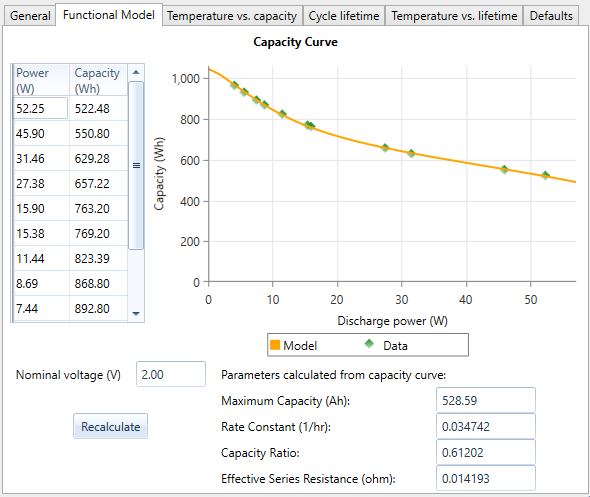
Variable |
Description |
Nominal voltage |
The no-load voltage of the battery model. You can generally set this to the manufacturer's nominal voltage of the battery. |
Maximum Capacity* |
The combined capacity of both tanks in the kinetic model, in amp-hours. See the article on the Kinetic Battery Model for details. |
Rate constant* |
The rate constant parameter specifies how quickly or slowly the two tanks of the kinetic model equalize, in units of 1/hr. See the article on the Kinetic Battery Model for details. |
Capacity ratio* |
The capacity ratio specifies the relative size of the two tanks of the kinetic battery model. See the article on the Kinetic Battery Model for details. |
R0* |
The series resistance that is added to the kinetic model, in ohms. See the article Modified Kinetic Battery Model for technical details. |
*This parameter is calculated from the data when you click Recalculate.
Depending on your selections in the Temperature vs. capacity, Cycle lifetime, and Temperature vs. lifetime tabs, these parameters are adjusted during the simulation to model degradation and variation of capacity with temperature.
Temperature versus Capacity Curve
Enter the relative capacity percentage of the nominal capacity for each temperature for the battery into the table on the left side of the page. Press the Recalculate button to calculate the three parameters for the quadratic fit. Also enter a maximum and minimum operating temperature. The battery is shut down outside of this temperature range.
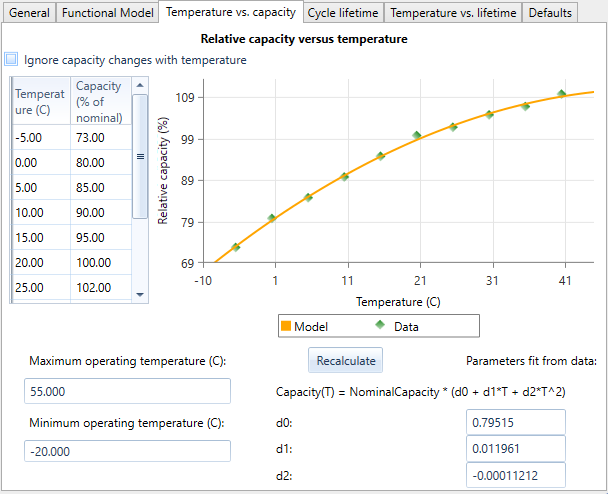
If you do not want to include temperature effects on capacity in the battery model, check the "Ignore capacity changes with temperature" box in the top left corner of the page. Checking this option sets the d0 term to 1.0, and d1 and d2 to zero, which makes the temperature 100% of nominal at all points.
Variable |
Description |
Maximum Operating Temperature |
Maximum temperature of the battery bank. Above this temperature, charging and discharging are not allowed. |
Minimum Operating Temperature |
Minimum temperature of the battery bank. Below this temperature, charging and discharging are not allowed. |
Fitted d0 |
Constant term in quadratic fit. |
Fitted d1 |
Coefficient of temperature in quadratic fit. |
Fitted d2 |
Coefficient of temperature squared in quadratic fit. |
Cycle Lifetime
Enter data for cycles for each depth of discharge (DOD) into the table and click Recalculate. HOMER calculates A and ? (beta) automatically from your data. If you enter a single point in the table and click Recalculate, HOMER assumes a constant throughput (? = 1). You can also manipulate A and ? manually if desired.
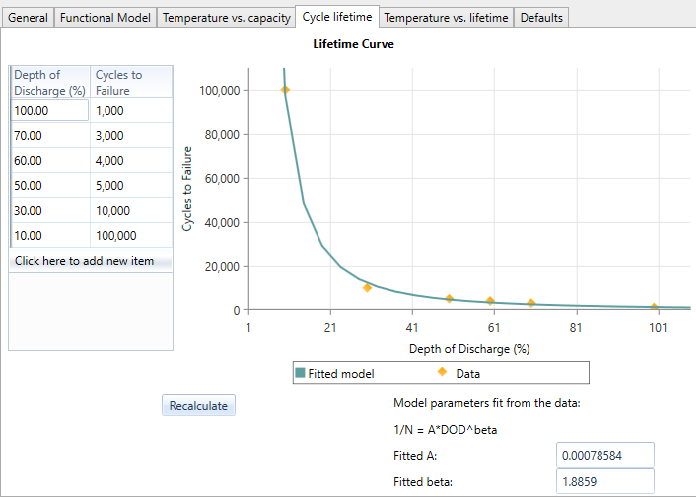
Variable |
Description |
Fitted A |
Coefficient fit from data entered in the table. For physical significance, the degradation limit (expressed as a fraction between zero and one) divided by A equals the nominal cycles to failure at 100% DOD. |
Fitted ? |
Exponent fit from data entered in the table. Set beta to 1 for a constant kWh of throughput to end of life. Set beta to 0 for a set number of cycles to failure, with no dependence on DOD. |
HOMER uses the Rainflow Counting Algorithm to calculate cycles and degradation from the state of charge time series in simulation. See the article Modified Kinetic Battery Model for more information.
Tip: The fit HOMER computes when you click Recalculate depends on the value of the Capacity degradation Limit input in the Default tab. If you change the value of the Capacity degradation Limit, you may want to Recalculate again.
Temperature versus Lifetime
Some datasheets or manufacturers can provide data for shelf life versus temperature. It is common for battery "shelf life" to be reduced at higher temperatures. Enter years versus temperature data into the table, and click Recalculate. HOMER fits an Arrhenius type equation to the data. Alternately, to choose a fixed lifetime in years, check the option at the top "Use constant shelf life regardless of temperature (years)" and enter the number of years to the right.
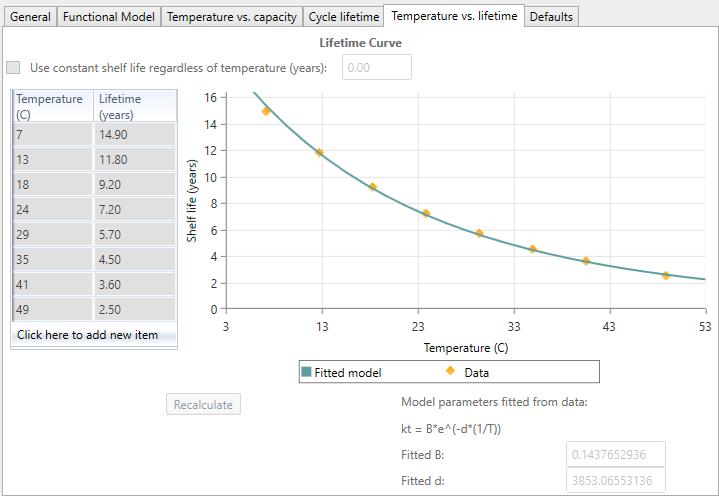
Variable |
Description |
Fitted B |
Coefficient of the model. Conceptually, this is equal to the inverse of the shelf life (in hours) times the Capacity degradation Limit as a fraction. |
Fitted d |
Coefficient of the exponential term in the model. A large value of d indicates a stronger temperature dependence. |
Tip: The fit HOMER computes when you click Recalculate depends on the value of the Capacity degradation Limit input in the Default tab. If you change the value of the Capacity degradation Limit, you may want to Recalculate again.
Defaults
In the Defaults tab, you can set the default values for all of the inputs that are displayed on the Design page when a user adds the component to a HOMER model, including the Cost table, Search Space, and Site Specific Inputs. You can modify any of these values on the Design page after you add the component to the model. You cannot add sensitivity values for these inputs in the Library, but you can add sensitivity values to the input after you add to the model on the design page.
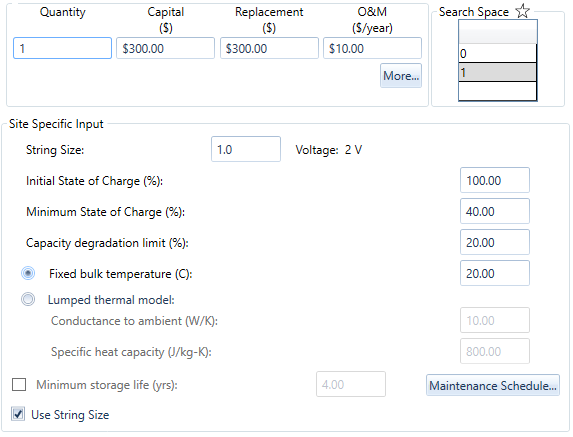
The values that you enter here are the default values displayed on the design page when you first add this component to a HOMER model. See the Modified Kinetic Battery section of the help for details on these inputs.
See Also
